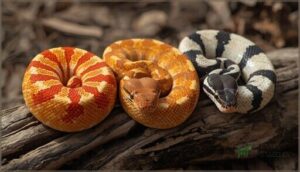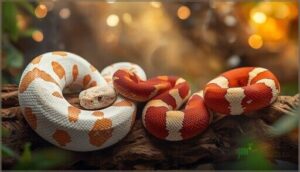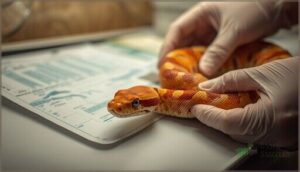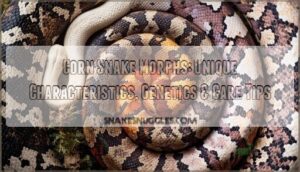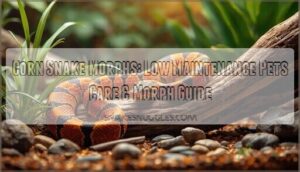This site is supported by our readers. We may earn a commission, at no cost to you, if you purchase through links.
Breeding corn snakes for designer morphs isn’t just about pairing pretty colors—it’s about understanding how a single gene mutation can turn a common orange serpent into a $500 Palmetto with bug eyes, or how three generations of line breeding might produce stunning visual results alongside heartbreaking spinal kinks.
The genetics behind corn snake morphs breeding information reveals a complex world where the CLCN2 gene controls everything from stripe patterns to melanin production, and where combining five different mutations from 28 selected strains can create something the hobby has never seen before.
You’re not playing a guessing game when you pair two snakes; you’re working with dominant, recessive, and codominant traits that follow predictable inheritance patterns—though the health consequences and market value of your choices require careful consideration before you ever introduce your breeding pair.
Table Of Contents
Key Takeaways
- Corn snake morphs follow predictable genetic inheritance patterns through dominant, recessive, and codominant traits controlled by genes like CLCN2, allowing you to strategically plan breeding outcomes rather than relying on guesswork.
- Line breeding accelerates desirable traits but concentrates harmful recessives like spinal kinks and craniofacial defects by the third generation, making outcrossing with unrelated stock essential for maintaining genetic health.
- Specific morphs carry documented health risks—Palmetto shows bug eyes in 40% of cases, Lavender experiences 10-12% clutch loss compared to the 3-5% baseline, and complex designer morphs face triple the dystocia rates at 7% versus 2%.
- Market values reflect both rarity and health considerations, with common morphs selling for $70-$130 while rare genetics like Palmetto and Scaleless command $500-$2,000, though ethical breeding prioritizes animal welfare over profit margins.
Corn Snake Morphs: Types and Classification
When you first start exploring corn snake morphs, the sheer variety can feel overwhelming—over 800 documented variations exist today. Understanding how breeders classify these morphs helps you make sense of the genetics and predict what traits your breeding projects might produce.
Let’s break down the main categories you’ll encounter, from single-gene color shifts to complex designer combinations.
Basic Color Variations (e.g., Red, Orange, Black)
Understanding basic color variations starts with the big three: red, orange, and black morphs. Red morph genetics dominate breeding programs, with that Carolina phase showing bold red saddles—you’ll see these in 37% of captive populations.
Orange hue intensity comes from carotenoid absorption, making orange corn snake morphs beginner favorites.
Black morph melanophores define Anerythristic snakes, where pigment cell differentiation blocks red completely, creating striking grayscale beauty. The color patterns are determined by the CLCN2 gene.
Pattern Variations (e.g., Motley, Striped, Banded)
Pattern variations reshape your corn snake’s look just as dramatically as color. Motley genetics create oval dorsal spots that blend together, appearing in 13% of captive-bred snakes. Stripe expression runs continuous lines down the body, commanding 15-20% higher prices than classic morphs. Banded breeding produces horizontal saddles, though only 8-10% of advertised hatchlings show true textbook banding. The corn snake’s skin color patterns are essential for survival.
Key Pattern Inheritance Facts:
- Both Motley and Stripes link to the CLCN2 gene mutation
- Pattern inheritance follows single-gene recessive models for Motley
- Banded morphs require multiple modifier genes across 6+ generations
- Patterned morphs represent 32-35% of market trends in 2025
Combination and Designer Morphs
Breeding corn snakes for designer morphs takes trait recombination to the next level, combining up to five genetic mutations from 28 selected strains. You’ll create visual uniqueness by pairing different morphs—like Snow, which requires two recessive traits simultaneously.
Hybrid morphs, such as Creamsicle (corn × rat snake), introduce hybrid vigor and novel interactions.
Over 800 combination morphs exist, though ethical concerns about genetic mutations persist.
Rare and Highly Sought-After Morphs
Among rare corn snake morphs, Palmetto and Scaleless stand out for their visual appeal and genetic scarcity, commanding morph market values from $500 to over $2,000.
These designer corn snakes face real breeding challenges—Scaleless females often show low fertility due to hybrid origins with Great Plains Rat Snakes, while Palmetto’s dominant mutation remains exceptionally difficult to produce consistently, making both highly prized in corn snake morph variations.
Genetics Behind Corn Snake Morphs
Understanding the genetics behind corn snake morphs is where breeding truly becomes an art form. The colors and patterns you see aren’t just random—they’re the result of specific genes interacting in predictable ways.
Let’s break down how these genetic mechanisms work to create the stunning variety you’re after.
Dominant, Recessive, and Codominant Traits
You’ve probably heard breeders toss around terms like “het” and “visual” when talking morphs—that’s genetics at work. Here’s what you need to master:
- Dominant inheritance means just one copy of the gene produces the trait, like Tessera morphs showing up when only one parent carries it
- Recessive expression requires two copies—amelanistic and anerythristic only appear when both parents pass the alleles down
- Codominant traits express both alleles equally, though they’re rarer in corn snakes than other reptiles
- Mendelian ratios predict your clutch outcomes: dominant crosses give 1:1, while recessive het pairings yield that classic 3:1 phenotype split
- Molecular confirmation through genome sequencing has mapped specific loci like the OCA2 gene disruption causing amelanism
Understanding these inheritance patterns turns breeding from guesswork into strategic planning.
Chromatophores and Pigment Cell Mutations
Your snake’s color comes from chromatophores—specialized cells controlling pigment production through three types: melanophores create black and brown, xanthophores produce yellow and red, while iridophores reflect light for brightness.
Genetic basis mutations in genes like LYST cause pigment trafficking defects, resulting in cellular effects that produce lavender morphs. Melanin loss mutations create albinos, and mutation prevalence varies widely between captive breeding programs and wild populations.
Inheritance Patterns and Gene Mapping
Understanding inheritance patterns starts with Mendelian genetics—tracking how alleles pass from parents to offspring. Gene linkage analysis reveals that corn snake morphs follow predictable segregation ratios, while genome annotation has identified 27,642 genes controlling traits.
Recombination hotspots create variation, and mutation identification pinpoints exact genetic changes.
Your breeding outcomes depend on recognizing whether traits follow dominant, recessive, or codominant genetic principles affecting gene expression.
Breeding Corn Snakes for Morphs
Breeding corn snakes for specific morphs isn’t just about pairing any two snakes together and hoping for the best. You’ll need to understand how to select compatible breeding pairs, choose between different breeding strategies, and create the right conditions for success.
Let’s break down the key factors that’ll help you produce healthy, vibrant morphs with the traits you’re after.
Selecting Compatible Breeding Pairs
Choosing the right breeding pair sets the foundation for your entire selective breeding program. You’ll need to evaluate genetic compatibility—like pairing amelanistic and anerythristic snakes for snow morphs—while verifying each snake meets minimum standards: females at 300g and three years old, males mature by 18 months.
Health verification and lineage tracking make certain you’re working with proven genetics, making morph predictability and successful corn snake breeding far more achievable.
Line Breeding Vs. Selective Breeding
Think of line breeding as doubling down on family traits, while selective breeding casts a wider net. Both shape your corn snake breeding program, but they work differently:
- Line breeding mates close relatives to heighten specific traits like vibrant coloration, tracking pedigrees over three generations to maintain consistency.
- Selective breeding pairs unrelated snakes based on desired characteristics, boosting genetic diversity and hybrid vigor while minimizing inbreeding risks.
- Trait heightening happens faster with line breeding, but concentrates harmful recessives alongside desirable genes.
- Breeding techniques combining both approaches give you trait stability and genetic health, essential for understanding corn snake genetics and managing long-term outcomes.
Hybrid and Combination Morph Breeding
When you cross species or stack multiple genetic traits, you’re unlocking a world beyond basic morphs—that’s where hybrid fertility and designer morphs shine. Jungle corns (corn snake × California kingsnake) and creamsicles (albino corn × Emory’s rat) demonstrate genetic stability across generations, while combination variations like snow morphs demand precise trait pairing.
Understanding these hybrid breeding approaches and breeding trends gives you combinatorial potential to create truly standout corn snake morphs, blending genetic traits you won’t find elsewhere.
Breeding Age, Weight, and Environmental Factors
Beyond genetic pairings, you need to nail the physical and environmental basics. Your corn snake breeding success depends on readiness milestones and proper conditions:
- Minimum breeding age: Females should be at least 3 years old, males around 2 years, ensuring mature body condition.
- Weight benchmarks: Aim for 300+ grams before breeding attempts.
- Thermal requirements: Maintain basking zones at 90°F, with brumation practices cooling to low 50s°F.
- Nesting environment: Provide damp substrate and stable humidity (65–75%) for healthy egg development.
Health Considerations in Morph Breeding
Breeding for stunning morphs is exciting, but you can’t ignore the health side of the equation. When you chase certain colors or patterns too aggressively, you risk passing along genetic problems that can seriously affect your snakes’ quality of life.
Let’s look at the key health factors you need to keep on your radar when breeding corn snake morphs.
Genetic Disorders and Inbreeding Risks
When you keep breeding closely related corn snakes, you’re playing with fire—hidden deleterious alleles surface fast. After three generations of line breeding, spinal kinks and craniofacial defects become noticeably more common.
Breeding closely related corn snakes brings hidden genetic defects to the surface, causing spinal kinks and craniofacial problems by the third generation
Outcrossing benefits are clear: introducing unrelated stock slashes genetic disorders while boosting genetic diversity.
Smart breeders now use marker selection to track harmful alleles, keeping heritability estimates in check without sacrificing the morphs you love.
Morph-Specific Health Concerns
While breeding strategies protect against general inbreeding, each morph brings its own set of risks you can’t ignore. Palmetto bug eyes affect up to 40% of those snakes, lavender spinal kinking hits 5-8% of some lines, and dystocia risks triple when you stack multiple designer genes. Here’s what you need to watch:
- Palmetto bug eyes reduce commercial value by 15-20%, though vision stays normal
- Lavender spinal kinking appears in select lineages, linked to the LYST gene mutation
- Dystocia risks climb to 7% in complex morphs versus 2% baseline rates
- Shedding disorders strike high-white morphs like Snow three times more often
- Pigment reduction morphs face greater dehydration and retained eye caps as juveniles
Stripe and Motley pattern morphs, thankfully, show no elevated health issues beyond baseline—regulatory mutations in CLCN2 alter appearance without compromising vitality.
Lavender females experience 10-12% clutch loss compared to the standard 3-5%, so factor that into your breeding goals. Veterinary intervention succeeds in 85% of dystocia cases if you catch it within 48 hours, making early detection your best friend.
Disease Resistance and Immunity Markers
Disease resistance in corn snakes hinges on genetic immunity markers inherited from both parents, microbiome defense on intact skin, and environmental factors like temperature and humidity. Physiological stress hormones weaken immune systems, while 43% of captive reptiles carry resistant Salmonella strains.
You’ll notice infection prevalence drops dramatically when you maintain proper husbandry—fungal zoospore viability plummets 3–20 times within 24 hours on healthy skin.
Advanced Breeding Techniques and Market Trends
Once you’ve mastered the basics of corn snake breeding, you can explore modern techniques that stretch genetic boundaries and improve your breeding outcomes. Understanding these refined methods, alongside current market dynamics, helps you make smarter decisions about which morphs to produce and how to preserve valuable genetics.
Let’s examine the techniques and trends that are shaping the direction of corn snake breeding.
Artificial Insemination and Embryo Transfer
You’re probably wondering if artificial insemination and embryo transfer can really transform your breeding program. These sophisticated breeding techniques show real promise, with fresh semen producing offspring and refrigerated samples staying viable for three days.
However, commercial adoption remains limited due to technical complexity and variable hatchling mortality rates—turned embryos showed 37.5% post-birth deaths versus 4.5% for unturned ones.
While these methods improve genetic diversity and genetic preservation techniques, they’re mostly used in conservation rather than everyday breeding operations.
Sperm Collection and Genetic Preservation
When you’re ready to master sperm collection, you’ll use gentle craniocaudal massage to retrieve viable semen within 2–3 minutes, achieving 92.5% sperm motility in fresh samples.
For genetic banking, refrigerated sperm storage maintains over 50% motility for 48 hours, while cryopreservation protocols recover about 30% post-thaw viability.
These genetic preservation techniques support artificial insemination in snakes, letting you preserve rare morphs and expand your sophisticated breeding techniques beyond natural reproduction limitations.
Pricing and Demand for Popular Morphs
How much does a morph’s rarity and color variation actually influence its market value? Common snake morphs like Amelanistic and Anery generally sell for $70–$130, while rare pattern variations such as Palmetto or Scaleless command $500–$2,000 due to scarcity and demand trend analysis.
Bright colors, compound genetics, and ethical morph sourcing drive buyer preferences, creating significant market entry barriers for beginners.
Planning a Successful Breeding Program
Building a successful corn snake breeding program isn’t just about pairing attractive morphs—it demands strategic planning from day one. Start with breeder selection focused on genetic diversity and health screening to avoid inbreeding depression, which genetic audits reduce by 30–40%.
Your foundation includes:
- Environmental Control: Maintain 60–75 day brumation cycles at 45–65°F
- Offspring Housing: Pre-plan space for 10–30 hatchlings per clutch
- Genetic Testing in Breeding: Track het status for 95% accurate morph predictions
Proper breeding pair selection and documented lineage transform hobby projects into sustainable operations.
Frequently Asked Questions (FAQs)
How do I care for corn snake eggs during incubation?
Fragile yet resilient, corn snake eggs need precise conditions to thrive. Maintain ideal temperature at 82°F, humidity levels around 70%, and proper substrate choice like vermiculite.
Consistent egg monitoring and awareness of hatch challenges throughout incubation are essential for healthy hatchlings.
What temperature produces male versus female hatchlings?
Incubation temperature doesn’t produce male versus female hatchlings in corn snakes. Unlike some reptiles, corn snakes use genetic sex determination rather than temperature-dependent systems, so your incubation setup won’t influence sex ratios.
How long between clutches should females rest?
Female corn snakes need at least 8-10 months rest between clutches, though a full 12-month breeding cycle is ideal.
This rest period prevents reproductive stress, aids calcium recovery, and maintains offspring health in your breeding program.
Can corn snakes breed with other snake species?
Yes, corn snakes can breed with closely related species like California kingsnakes and rat snakes, producing viable designer morphs such as jungle corns and creamsicles.
Though interspecies barriers make success rates vary considerably.
What permits are needed to breed corn snakes commercially?
State requirements vary widely, but most demand a commercial breeder license and regular inspections. Federal regulations apply mainly to interstate sales, while local ordinances can add stricter restrictions on facility operations and breeding numbers.
Conclusion
Think of each breeding decision as a brushstroke on a living canvas—one wrong pairing can blur the masterpiece you’re creating.
Your corn snake morphs breeding information arsenal now includes the genetic roadmap, health safeguards, and market insights to produce stunning animals responsibly.
The difference between a backyard hobbyist and a respected breeder lies in understanding that every gene you combine writes a story in scales, and you’re the author deciding whether that tale ends in beauty or regret.
- https://a-z-animals.com/blog/corn-snake-morphs-the-complete-list/
- https://community.morphmarket.com/t/corn-snake-breed-genetics/29705
- https://www.reddit.com/r/cornsnakes/comments/x1qff2/corn_snakes_breeding_phases_and_morphs/
- https://en.wikipedia.org/wiki/Corn_snake
- https://www.cornsnakes.com/forums/showthread.php?t=15985


